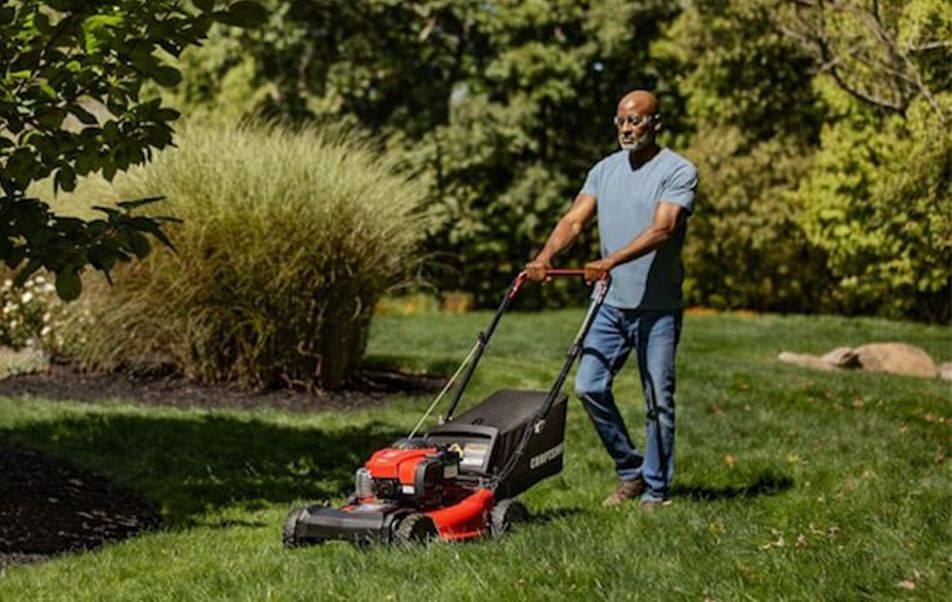The lawnmower is a gardening tool that you use quite frequently for a good part of the year except, in principle, during the winter. If you are thinking of changing your old push mower, why not consider a self-propelled model, that is, a self-propelled one? What are the benefits?
- It moves by itself because the motor is connected to the wheels and transmits the driving force to them.
- You don’t need to push it, just give it direction.
- It also advances uphill and on rough terrain.
In practice, a self-propelled lawn mower is much more manageable than a push-type lawn mower: it is a machine that makes you mow with less effort and in less time . And if mowing isn’t one of your favorite pastimes, the self-propelled lawn mower eases the task a lot . In short, a nice gain by investing a little more than a push model of the same or similar power. Now, let’s see how to choose your self-propelled lawnmower.
What to consider of a self-propelled lawn mower: power supply, engine and body
Of a self-propelled lawn mower, first of all, look at the power supply: better a self-propelled petrol, battery or electric lawn mower? In general, petrol lawn mowers, even in the traction version, are more powerful. In addition, with a petrol lawn mower you have no constraints of any kind: proximity to the power outlet, length of the power cable, autonomy and battery recharging times.
When comparing multiple types of self-propelled petrol lawn mowers, consider the power and displacement of the engine. The higher the power, the higher the performance of a machine. This means you work faster and mow even the toughest surfaces : expansive lawns, covered with tall, leathery grass, uphill, bumpy (or, in more difficult cases, a mix of all of these).
From the soul of the lawnmower – the engine -, we move on to the body: the body. To tackle the most demanding jobs, it is better to focus on metal bodies, more robust than plastic ones. Efco self-propelled lawn mowers have a steel or aluminum frame : resistant to stones, uneven ground, collisions with sidewalks and walls.
How to choose a self-propelled lawn mower: cutting features and extras
Now, let’s focus on the cutting characteristics of self -propelled lawn mowers, that is:
- Cutting width
- Cutting height
- Cutting functions
The cutting width depends on the length of the blade: the larger it is, the faster the work because, for the same area to mow, you only need fewer mower passes.
The cutting height must be adjustable, so that you can easily adapt it to both the characteristics of the grass and seasonal needs. All the Efco self-propelled models we have mentioned have centralized cutting height adjustment: you do not have to set the height of each wheel, but with a single command you set how high you want the lawn, between a minimum of 2 and a maximum of 7 , 5 cm.
Once the grass is cut, what are you going to do with it? You can dispose of it with the separate collection of greenery, compost it to make organic substance for the vegetable garden and the garden, use it as mulch or use it directly as fertilizer for the lawn itself. For these different cases you need different cutting features:
- Rear discharge equipped with large grass catcher , available from 70 to 80 liters for Efco self-propelled lawn mowers .
- Side discharge : together with the rear discharge equipped with a deflector, it allows you to accumulate the clippings along the lawn as you mow.
- Mulching system : shreds the grass and distributes it without creating clusters on the lawn, where it decomposes quickly, so you avoid having to collect it.
What other aspects is it useful to keep in mind when choosing a self-propelled petrol lawn mower ? Surely the easy starting system of the engine , such as the InstartIS battery electric starter or the ReadyStart which automatically detects the engine temperature and supplies it with the right amount of gasoline, without you having to use the primer and regulate the air with the choke.
Also consider the wheels: if they are large – therefore suitable for moving easily on the most uneven terrain – and robust, perhaps in aluminum.
The maintenance of the self-propelled petrol lawn mower
We conclude with a check-list of essential checks to do to keep your self-propelled petrol lawn mower in good condition:
- Cleaning the mower deck.
- Cleaning the crankcase air intakes.
- Inspection of tightening of nuts and screws.
- Cleaning the cutting deck and blade.
- Check the condition and sharpness of the blade.
- Check the condition of the mulching kit components.
- Checking the grassbox and rear discharge deflector.
- Cleaning / replacing the air filter.
- Cleaning, checking the gap between the electrodes (and replacing them if necessary) of the spark plug.
- Cleaning the engine cylinder fins.
When servicing the petrol lawn mower, make sure that the engine is cold and the spark plug cap is disconnected and, when handling the blade, always use work or cut-resistant gloves.
So, better a self-propelled or push lawn mower? If you still have any doubts, you can read this overview on everything you need to know before buying a lawn mower.




